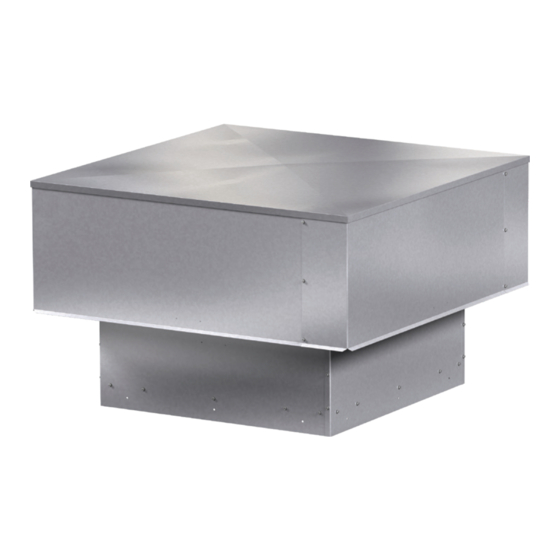
Greenheck RSF Installation, Operation And Maintenance Manual
Roof supply fan
Hide thumbs
Also See for RSF:
- Installation, operation and maintenance manual (9 pages) ,
- Assembly instructions manual (12 pages)
Table of Contents
Advertisement
Quick Links
®
Installation, Operation and Maintenance Manual
Please read and save these instructions for future reference. Read carefully before attempting to assemble, install,
operate or maintain the product described. Protect yourself and others by observing all safety information. Failure
to comply with these instructions will result in voiding of the product warranty and may result in personal injury
and/or property damage.
Centrifugal Supply Fans
Fans are specifically designed for filtered roof supply applications.
Fans feature permanent washable aluminum filters for years of reliable
use and double-width forward-curved wheels for high efficiency and
low sound. Available with straight-sided hood.
General Safety Information
Only qualified personnel should install this fan.
Personnel should have a clear understanding of these
instructions and should be aware of general safety
precautions. Improper installation can result in electric
shock, possible injury due to coming in contact with
moving parts, as well as other potential hazards.
Other considerations may be required if high winds
or seismic activity are present. If more information is
needed, contact a licensed professional engineer before
moving forward.
1. Follow all local electrical and safety codes, as well as
the National Electrical Code (NEC) and the National
Fire Protection Agency (NFPA), where applicable.
Follow the Canadian Electric Code (CEC) in Canada.
2. The rotation of the wheel is critical. It must be free
to rotate without striking or rubbing any stationary
objects.
3. Motor must be securely and adequately grounded.
4. Do not spin fan wheel faster than max cataloged fan
RPM. Adjustments to fan speed significantly affect
motor load. If the fan RPM is changed, the motor
current should be checked to make sure it is not
exceeding the motor nameplate amps.
5. Do not allow the power cable to kink or come in
contact with oil, grease, hot surfaces or chemicals.
Replace cord immediately if damaged.
6. Verify that the power source is compatible with the
equipment.
7. Never open access doors to a duct while the fan is
running.
®
DANGER
Always disconnect, lock and tag power source before
installing or servicing. Failure to disconnect power
source can result in fire, shock or serious injury.
CAUTION
When servicing the fan, motor may be hot enough
to cause pain or injury. Allow motor to cool before
servicing.
CAUTION
Precaution should be taken in explosive atmospheres.
DANGER
Pour écarter les risques d'incendie, de choc électrique
ou de blessure grave, veiller à toujours débrancher,
verrouiller et étiqueter la source de courant avant
l'installation ou l'entretien.
ATTENTION
Lors de toute intervention sur la soufflante, le moteur
peut être suffisamment chaud pour provoquer une
douleur voire une blessure. Laisser le moteur refroidir
avant toute maintenance.
ATTENTION
Faire preuve de précaution dans les atmosphères
explosives.
Document 453148
Models RSF
Roof Supply Fan
Roof Supply Fan
1
Advertisement
Table of Contents

Summary of Contents for Greenheck RSF
- Page 1 Document 453148 Models RSF Roof Supply Fan ® Installation, Operation and Maintenance Manual Please read and save these instructions for future reference. Read carefully before attempting to assemble, install, operate or maintain the product described. Protect yourself and others by observing all safety information. Failure to comply with these instructions will result in voiding of the product warranty and may result in personal injury and/or property damage.
- Page 2 Receiving Storage Environment The ideal environment for the storage of fans and Upon receiving the product, check to ensure all items accessories is indoors, above grade, in a low humidity are accounted for by referencing the delivery receipt or atmosphere which is sealed to prevent the entry of packing list.
-
Page 3: Dimensional Data
hard to reach internal surfaces or for occasional use, ® ® consider using Tectyl 511M Rust Preventive, WD-40 or the equivalent. Removing From Storage As fans are removed from storage to be installed in their final location, they should be protected and maintained in a similar fashion until the fan equipment goes into operation. -
Page 4: Typical Installation
Typical Installation Move the fan to its intended location and fasten it securely through mounting holes provided in the fan base. Shims may be necessary depending upon thickness of the roofing material. Prepunched mounting holes and 2-1/2 in. skirt For ducted applications, an optional duct adapter (if to aid in installation. - Page 5 Mounting for High Wind Installation Fan to Curb: Three (3) fasteners are required Curb to Deck: per side on all sides. Must be equally spaced. STEEL ANCHORING Roof Curb Thru Bolt Option: Anchor Option: Roof Supply Fan 1/2 in. 300 series bolt with 5/16 in.
-
Page 6: Pre-Start-Up Checks
Backward Inclined Forward Curved Pre-Start-Up Checks Airflow Direction of fan wheel rotation is critical. A fan wheel Airflow DANGER rotating in the wrong direction will result in reduced Disconnect and secure to the “off” position all airflow, motor overloading electrical power to the fan prior to inspection or and possible burnout. -
Page 7: Maintenance
Maintenance larger motor frames. To adjust belt tension on units DANGER equipped with the painted steel motor bracket, simply Disconnect and secure to the “off” position all adjust the single jack screw. electrical power to the fan prior to inspection or For units equipped with a galvanized motor plate, both servicing. -
Page 8: Parts List
As a result of our commitment to continuous improvement, Greenheck reserves the right to change specifications without notice. Product warranties can be found online at Greenheck.com, either on the specific product page or in the literature section of the website at Greenheck.com/Resources/Library/Literature.











Need help?
Do you have a question about the RSF and is the answer not in the manual?
Questions and answers